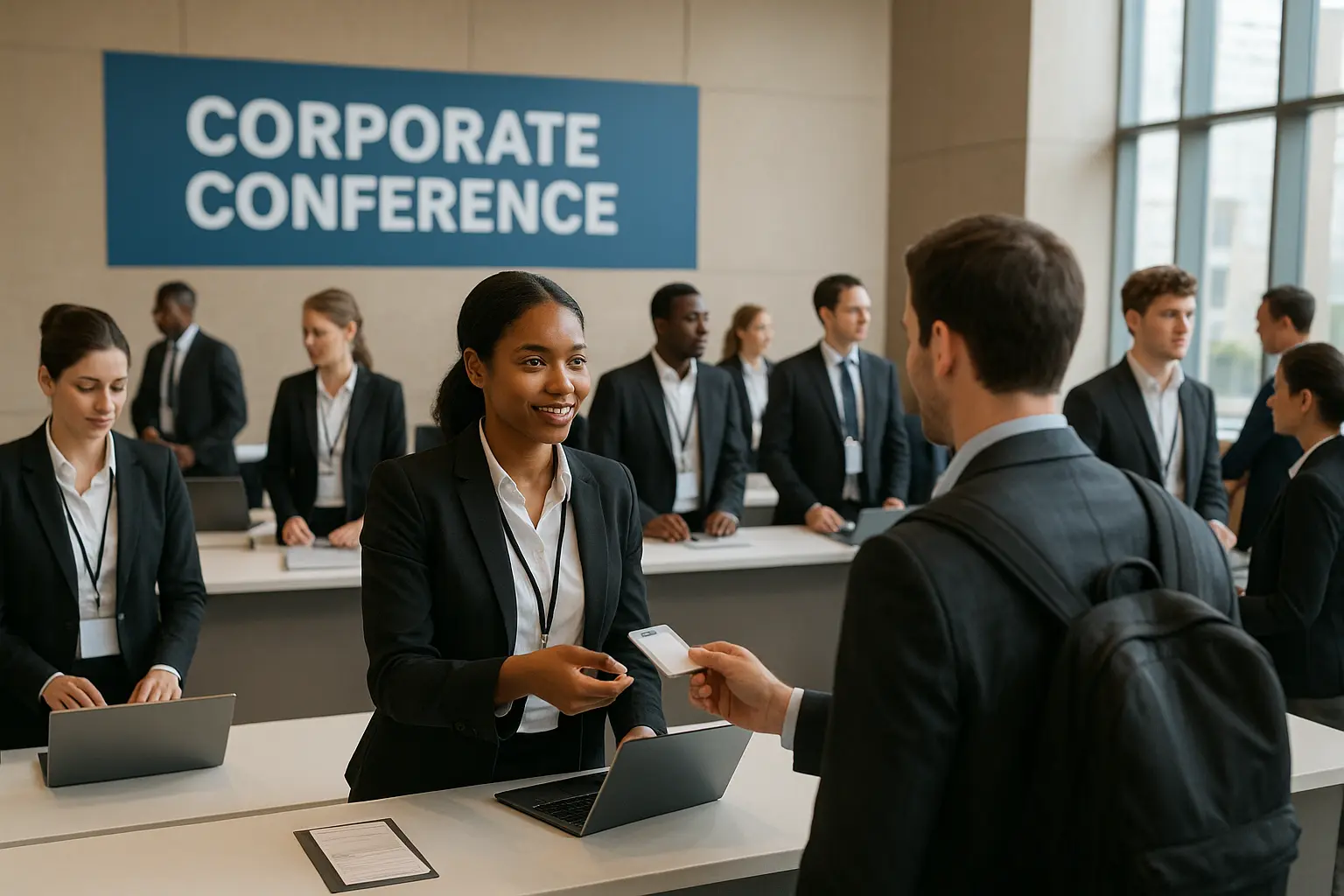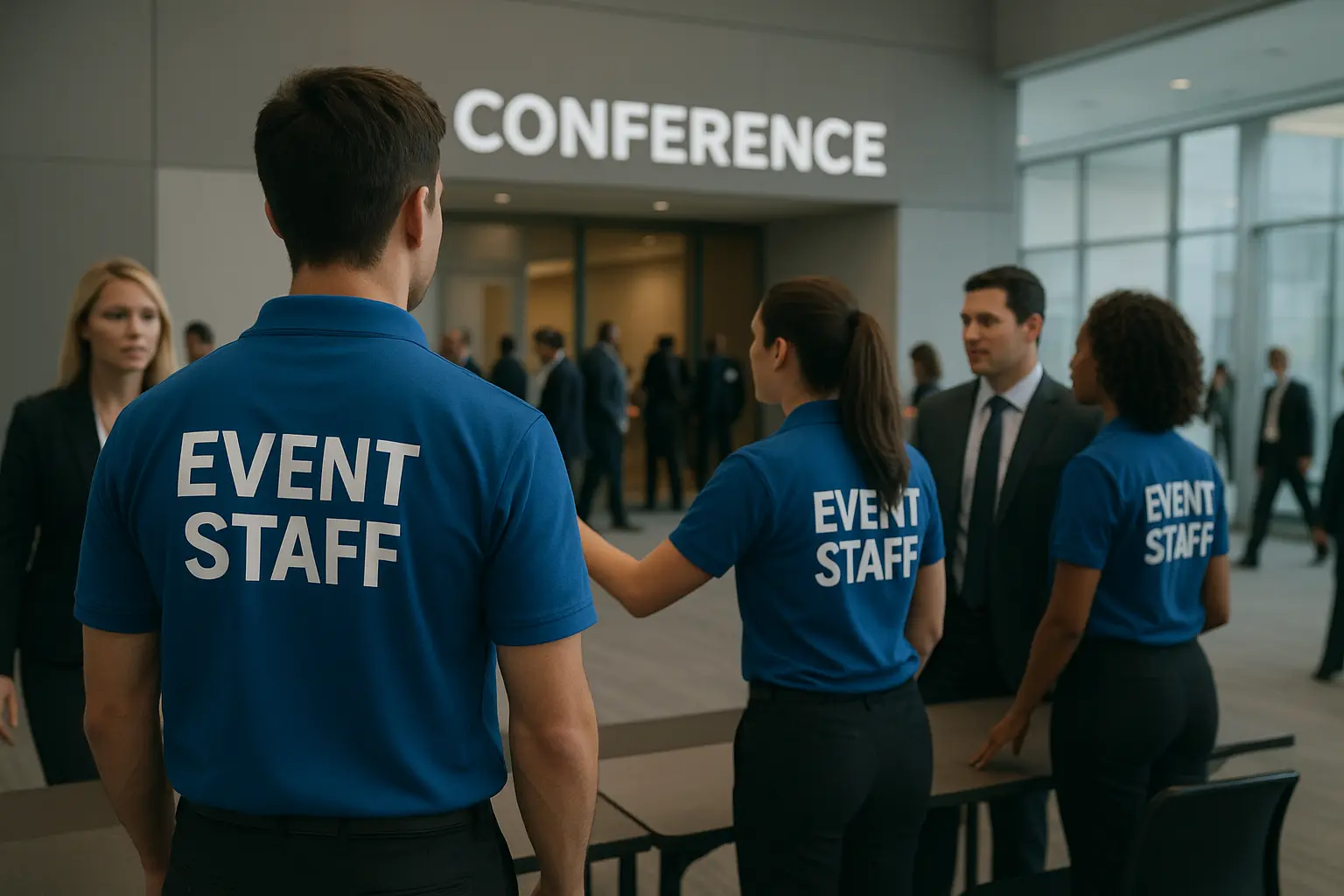CEO Excerpt
"At the 1,000+ attendee scale, 'hope' is not a strategy. To hire staff for large corporate event success, you must buy a proven operational model—one built on precise ratios and a clear supervisor chain. That is the only way to protect the guest experience."- CEO Event Staff
To hire staff for large corporate event success, you must plan for 30 to 45 trained personnel for every 1,000 attendees. This isn't a guess; it's the operational baseline.
Why the range? Your final number depends on the venue's complexity (e.g., multiple floors), the intensity of arrival waves, and the scope of service required. A simple, single-room keynote is different from a 12-track breakout session.
Regardless of the final count, your event staffing for 1000 attendees must prioritize four key zones: registration, breakout room support, expo floor flow, and guest directionals. A failure in any of these zones creates a bottleneck that cascades through the entire event.
This corporate conference staffing guide provides the exact staffing models, ratios, and supervisor chains to prevent that failure.
Executive Summary
This corporate conference staffing guide provides the exact operational model to hire staff for large corporate event success. We detail precise staff-to-guest ratios, supervisor chains, and zonal headcounts for 1,000+ attendee events.
Why Large Conferences Fail Without Proper Staffing
Staffing at this scale is not a cost center; it's a risk management strategy. When you hire staff for large corporate event operations, you are buying operational insurance against the three most common (and visible) points of failure:
- The 5-Minute Check-in Delay: A five-minute wait at registration doesn't just annoy a guest; it damages sponsor visibility. It means attendees are frustrated before they even see the first multi-million dollar booth. Research on Attendee Pain Points confirms that a poor entry experience taints their perception of the entire event.
- The Directional Void: One attendee asking an untrained staffer "Where is Breakout C?" is fine. Fifty attendees asking at once creates crowd compression at escalators and doors. Inconsistent instructions erode the premium, elevated guest experience you've spent millions to build.
- The "Missing Lead" Dead Zone: When a supervisor or zone lead is missing, staff create idle time, coverage gaps appear, and problems go unsolved. A spill, a tech failure, or a VIP issue is ignored for 10 minutes instead of 10 seconds.
Ultimately, a proper corporate conference staffing guide isn't just about bodies; it's about protecting brand trust, sponsor ROI, and attendee NPS. This is a core part of the decision to hire staff for large corporate event success.
Build the 1,000-Attendee Model and Flow Plan
Your event staffing for 1000 attendees is not one single team; it's a system of specialized "micro-teams" deployed to high-friction zones. Use this model as your starting point.
Registration & Badge Scanning: 12-18 Staff
This is your frontline. Roles must be specialized: Check in Staff for ID verification and badge issuing, dedicated problem-resolution specialists, and highly visible greeters to direct flow before they hit the tables.
Breakout Support: 8-14 Staff
This team ensures the "content" part of your conference runs flawlessly. Roles include room timing (holding doors until a session ends), managing Q&A mic runners, monitoring door flow, and acting as human signage for directionals. This requires professional Conference Staff trained for this specific environment.
Expo Floor & Runners: 12-18 Staff
In Trade expos, this team's job is twofold: aisle guidance for attendees and proactive support for sponsors. They are your "runners," replenishing sponsor collateral, reporting booth issues, and ensuring sponsors can maximize ROI. This is where strategic workforce planning directly impacts revenue.
F&B Service Points: 10-16 Staff
This team is pure crowd control. Their mission is to manage lines at coffee/lunch buffets, keep tables bussed, ensure replenishment, and handle immediate spill control.
Floaters for Surges: 4-6 Staff
These are your "problem solvers"—experienced staff held at a central point, ready to be deployed by a supervisor to a registration surge, a full breakout room, or a security assist.
Supervisors & Leads: 6-9 Total
The command structure that holds the entire plan together. (More on this in the next section).
Use this model to hire staff for large corporate event accuracy before you lock in your final budgets.
Role Ladder and Supervisor Chain
You cannot hire staff for large corporate event operations and just "hope" they self-organize. You must build a command structure. A flat structure with 45 staff reporting to one client is a guaranteed failure.
Your role ladder must be tiered for clear communication and rapid problem-solving:
Tier 1: General & Specialist Staff
The frontline, as defined above.
Tier 2: Zone Leads
An experienced staffer who manages a small pod. The Lead Ratio is critical: one (1) Zone Lead for every six (6) general staff. This keeps the effective span control tight.
Tier 3: Supervisors
The "manager of managers." A supervisor oversees 3-5 Zone Leads. They are your on-floor decision-makers, managing rotations, handling escalations, and re-deploying floaters.
Tier 4: Client Liaison
This is your one point of contact. This person (often from your agency's core Production Teams) aligns directly with your ops lead, captures all change requests, and approves any real-time adjustments.
This chain ensures that a problem is solved by a Zone Lead in seconds, not escalated to a busy client 15 minutes later. When you hire staff for large corporate event teams, you are buying this proven supervisor chain as much as the staff themselves.
Zone Assignments and Arrival Windows
Static positions don't work at this scale. When you hire staff for large corporate event operations, you must assign teams to specific, high-friction zones: doors, corridors, escalator landings, and room clusters.
The most critical zone is the entry. We use a non-negotiable arrival surge rule: one guest-facing staffer for every 25 guests during that peak 60-minute entry window.
This entire system is managed with radios using a single, clear call sign format for rapid relocations. This zonal approach prevents crowd compression at bottlenecks and protects sponsor sightlines—a core principle of effective Crowd Management.
Multi-Day Crew Rotations and Briefings
A three-day conference is an endurance race. Your event staffing for 1000 attendees must be built for it.
The operational standard is an 8-hour rotation. (This mitigates OSHA worker fatigue). Critically, you must hold a 10-15 percent backup crew daily for sickness, no-shows, or operational overruns.
Briefings are the glue that holds the multi-day plan together and must follow a strict cadence:
Day 0
Safety, venue layout, and SOPs.
Day 1 (AM)
Specific roles, timing, and radio checks.
Mid-day
Reset for the afternoon shift.
Day-End
Debrief on metrics and issues.
We also retain 60-70% of the same crew across all days. This continuity protects familiarity and speed. Stable rotations reduce errors and training friction, which is vital when you hire staff for large corporate event teams.
Calculate Staffing Costs for a 1,000+ Attendee Corporate Conference
Let's move from theory to budget. This is the fast-estimate formula our ops leads use for a 1,000-attendee corporate conference staffing guide.
Base Guest-Facing Staff
Attendees ÷ 30 (e.g., 1000 / 30 = ~34)
Add Specialists
+6 to +12 for registration, scanning, and breakout support.
Add Supervisors
Minimum 2 per 500 attendees (e.g., +4).
Add Multi-Day Buffer
+10% of total headcount (e.g., ~4)
Worked Example
34 (Base) + 8 (Specialists) + 4 (Supervisors) + 4 (Buffer) = Total: ~50 staff.
Note that final costs will vary based on market (e.g., NYC vs. Orlando) and role seniority. Using a clear formula when you hire staff for large corporate event planning is the only way to prevent mid-show overruns and emergency rush fees.
Three Conference Scenarios and How to Staff Them
Your headcount model must adapt to your conference format. A single keynote is not a multi-track learning day. Here are three common scenarios.
Single Venue, Single Track
Deploy heavier at registration early, then shift floaters to breakout doors after the surge. Maintain two supervisors.
Multi-Track Learning Day
This format is more complex. Place more room assistants and runners. Increase the number of Zone Leads to maintain strict timing discipline and Q&A mic flow.
VIP-Heavy Executive Summit
This is about high-touch service, not volume. Reduce the guest-to-staff ratio to 1:15 at entry and concierge points. Add a dedicated liaison, such as a Hostesses, for VIP holds and private room management.
These patterns help you hire staff for large corporate event formats with predictable outcomes.
Partner Criteria for Enterprise Scale
Event staffing for 1000 attendees is an enterprise-level operation. Your partner must have the infrastructure to match. Look for three non-negotiable criteria:
A Multi-City Roster & Proven Supervisor Network
They must be able to deploy a trained team in your main and secondary markets.
Pre-Trained Conference Specialists
You don't have time to train on-site. They must provide staff already proficient in registration, scanning, and room support, essential for trade shows.
Documented SOPs
Ask for their standards on uniforms, compliance coverage, radio etiquette, and 4-hour minimums.
Premier Staff provides pre-trained conference teams, proven supervisor chains, and multi-city deployment for 1,000+ attendee events.
A Proven Model for 1,000+ Attendee Events
For enterprise programs, hiring staff for large corporate event operations demands proven systems. Premier Staff provides exactly that: trained conference teams, multi-city coverage, and documented SOPs. When you're ready to see this model in action, you can request a custom quote and staffing model from our ops team to plan your multi-day deployment. We build in the supervisor chains and backup crews necessary for enterprise-scale success.



.webp)

